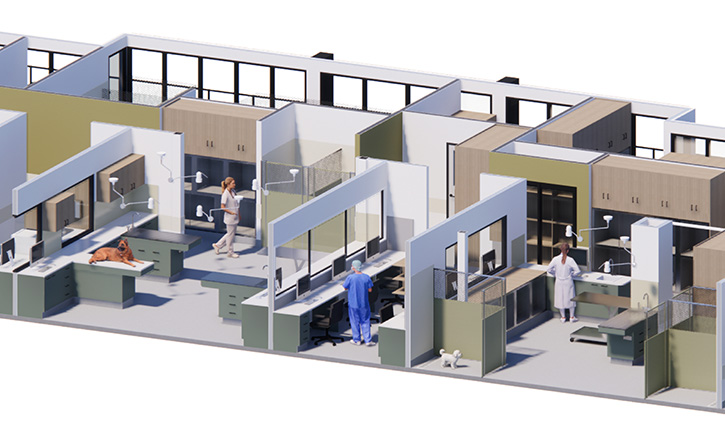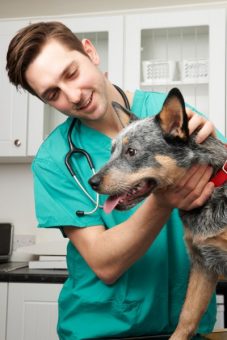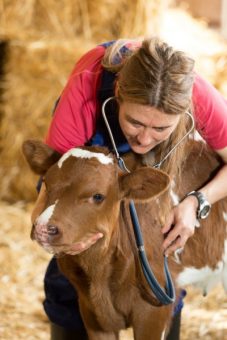

Hyperthyroidism is the most prevalent endocrine disease in cats over 10 years of age. First described in cats in the late 70s, increases in the feline population, availability and use of total thyroid hormone tests and extensions in life expectancy has seen the number of cases within clinics rise.
Most cases of hyperthyroidism will be straightforward to diagnose and treat with current treatment options available to clinicians including the chemotherapy treatment, radioactive iodine, surgical thyroidectomy, topical compounded medications or tablets. The challenge in practice and for the cat’s owner is that tablet medication is most often prescribed and therefore most clients must learn to regularly tablet their cat to be compliant.
In November 2022 the team at Norbrook® announced the launch of Thyronorm® Oral Liquid for Cats to manage feline hyperthyroidism. Dr Michael Dhar, Norbrook’s Technical Services Manager, comments “Cats with hyperthyroidism are difficult to treat initially because of the aggressive behavioural changes that occur with the disorder. Medical treatment always begins the treatment plan as either a precursor to other options or lifelong management of hyperthyroidism and is over 95% successful in returning cats to a euthyroid state.
Thyronorm oral liquid now provides Australian vets with a registered alternative to  making their clients tablet a cat with hyperthyroidism”.
making their clients tablet a cat with hyperthyroidism”.
Thyronorm oral liquid contains 5mg/mL thiamazole (also known as methimazole in the US) that inhibits the production of thyroid hormone by the thyroid gland, in a palatable liquid formulation that has an ISFM (https://icatcare.org/) easy to give award.
The liquid thiamazole formulation provides an alternative to any tablet version including the human carbimazole formulation that is a prodrug of thiamazole.
“Carbimazole is immediately converted to thiamazole in plasma which is the active molecule within the body. It is important to recognise that the molar equivalent of carbimazole is not the same as thiamazole, so when converting doses between the two some maths needs to be done,” he continues.
“Thyronorm also provides an alternative to the compounded topical thiamazole formulations as a registered medication that also has the benefit of reducing any possibility of accidental exposure to other pets or humans that may occur with topical medicines when prescribed.”
“We’ve received fabulous feedback about their use of Thyronorm from vet clinics so far.”, Michael adds. “It’s great to be able to share these stories but they are but a few of the cases we are hearing about.”
 “One of our most recent cases is a cat that was having difficulties consuming tablets, so we transitioned to Thyronorm and now they are well controlled as they are now taking medication easily and dosing is not a stressful time for patient or client anymore.” – Tori Calleja (Senior Veterinary Nurse) from Brimbank Vet Clinic.
“One of our most recent cases is a cat that was having difficulties consuming tablets, so we transitioned to Thyronorm and now they are well controlled as they are now taking medication easily and dosing is not a stressful time for patient or client anymore.” – Tori Calleja (Senior Veterinary Nurse) from Brimbank Vet Clinic.
“Owner has historically had trouble tableting Patient X, so the accessibility and ease of administration seemed like a win win.” – Tanya Finneran (Head Veterinary Nurse) from Coast Animal Health.
“We have a highly aggressive cat called Patient X. When she was diagnosed with Hyperthyroidism we where devastated as no one could tablet the cat. We started her on Thyronorm and she takes it like a treat and the owner is able to give the medication at home! She is currently doing really well and t4 is within normal limits!” – Megan McCubbin from Monier Vet Clinic.
Patient X’s owner was already giving tablets and was struggling to tablet Patient X. Our Vet discussed Thyronorm with Patient X’s owner and they jumped at the chance to have a product that’s easy to use and make compliance of giving medication everyday more successful. Patient loves Thyronorm and his owner is so happy they changed! – Natasha Jones (Veterinary Practice Manager) from McLaren Vale Veterinary Surgery.
Thiamazole is a bitter tasting medication. In tablet form it needs to be covered in a casing to prevent the patient tasting the active ingredient. This creates challenges to a vet’s management plan of hyperthyroidism when minor dose adjustments are needed to reach target levels as we are either asking clients to then give two tablets or if they give a halved tablet there is the opportunity for cats to react to the bitter taste of thiamazole.
With previous success in formulating liquid oral medications for cats the Norbrook research team were challenged by vets to create a liquid version of thiamazole. The feedback from practicing vets was that a liquid thiamazole medication would assist compliance and management plans greatly in the medical treatment of feline hyperthyroidism. The formulation created uses honey flavouring over the top of a solution that has removed the upfront bitter taste of thiamazole.
 He adds, “Feedback from our colleagues in the UK was to expect 70% of cats will readily accept Thyronorm from the syringe and that’s exactly what we have found. After a little initial training to get them used to the taste and receiving treatment from a syringe, cats are coming to their owners to receive Thyronorm as they think it is a treat.”
He adds, “Feedback from our colleagues in the UK was to expect 70% of cats will readily accept Thyronorm from the syringe and that’s exactly what we have found. After a little initial training to get them used to the taste and receiving treatment from a syringe, cats are coming to their owners to receive Thyronorm as they think it is a treat.”
The Thyronorm formulation allows dose adjustments of 1.25mg (0.25mL) to be made to ensure the dose given can more readily match the management plan resulting in blood total thyroid levels at the vet’s desired target range.
Co-morbidities are common in cats that have hyperthyroidism with concurrent renal insufficiency occurring in as many as 20% of cases. Tachycardia, volume overload through adrenergic stimulation and hypertension can artificially increase GFR (glomerular filtration rate) by 100% when hyperthyroidism exists. “Hyperthyroidism results in renal damage through renal hypertension and glomerular sclerosis resulting in this population of cats having a higher incidence of renal disease.” Euthyroidism will limit on-going renal damage and if renal disease exists that should be managed concurrently. As renal insufficiency is suspected at such a high rate prior to hyperthyroid management on-going monitoring of renal parameters when monitoring blood thyroid hormone levels is strongly recommended.
A small percentage of feline hyperthyroidism cases are a consequence of a malignant thyroid adenocarcinoma rather than the more common benign adenoma. “If response to medical management is not resulting in the expected reduction in blood thyroid hormone levels then consider the small risk of an adenocarcinoma being present.” Adenocarcinomas follow on from benign adenomas generally over an extended period beyond 3 years as a consequence of further mutations. Outcomes in treatment and management of adenocarcinoma cases are less predictable.
 Thyronorm is expected to ensure the pet parent bond continues with him adding “Thyronorm has been available in the UK since 2016 and the vets have made it their number one prescription for feline hyperthyroidism. With this endorsement from our colleagues, we are sure that these early results from Australian vets across 2023 will continue.” Norbrook have been manufacturing medicines since 1969 to enhance the health of animals, “This innovative product was driven by vets voicing their frustrations at current therapy options, we are proud as a company to have developed and delivered Thyronorm.” he finishes.
Thyronorm is expected to ensure the pet parent bond continues with him adding “Thyronorm has been available in the UK since 2016 and the vets have made it their number one prescription for feline hyperthyroidism. With this endorsement from our colleagues, we are sure that these early results from Australian vets across 2023 will continue.” Norbrook have been manufacturing medicines since 1969 to enhance the health of animals, “This innovative product was driven by vets voicing their frustrations at current therapy options, we are proud as a company to have developed and delivered Thyronorm.” he finishes.
Thyronorm provides a simple solution to the complex problem of feline hyperthyroidism. The first and only registered oral liquid therapy for cats to manage hyperthyroidism in Australia. It is the easy, safe, and effective option.
*Thiamazole is the international name of US adopted name methimazole.
Contact Norbrook:
Email: customercare@norbrook.com.au
Website: https://www.norbrook.com/
Click Here to watch our Video








 making their clients tablet a cat with hyperthyroidism”.
making their clients tablet a cat with hyperthyroidism”.
 He adds, “Feedback from our colleagues in the UK was to expect 70% of cats will readily accept Thyronorm from the syringe and that’s exactly what we have found. After a little initial training to get them used to the taste and receiving treatment from a syringe, cats are coming to their owners to receive Thyronorm as they think it is a treat.”
He adds, “Feedback from our colleagues in the UK was to expect 70% of cats will readily accept Thyronorm from the syringe and that’s exactly what we have found. After a little initial training to get them used to the taste and receiving treatment from a syringe, cats are coming to their owners to receive Thyronorm as they think it is a treat.” Thyronorm is expected to ensure the pet parent bond continues with him adding “Thyronorm has been available in the UK since 2016 and the vets have made it their number one prescription for feline hyperthyroidism. With this endorsement from our colleagues, we are sure that these early results from Australian vets across 2023 will continue.” Norbrook have been manufacturing medicines since 1969 to enhance the health of animals, “This innovative product was driven by vets voicing their frustrations at current therapy options, we are proud as a company to have developed and delivered Thyronorm.” he finishes.
Thyronorm is expected to ensure the pet parent bond continues with him adding “Thyronorm has been available in the UK since 2016 and the vets have made it their number one prescription for feline hyperthyroidism. With this endorsement from our colleagues, we are sure that these early results from Australian vets across 2023 will continue.” Norbrook have been manufacturing medicines since 1969 to enhance the health of animals, “This innovative product was driven by vets voicing their frustrations at current therapy options, we are proud as a company to have developed and delivered Thyronorm.” he finishes.




 January 2019
January 2019 So is there a shortage of vets – and is it due to vets quitting the profession?
So is there a shortage of vets – and is it due to vets quitting the profession? An interesting study, again from the BVA and University of Exeter, released in 2018, investigated gender bias in the veterinary profession (
An interesting study, again from the BVA and University of Exeter, released in 2018, investigated gender bias in the veterinary profession ( 